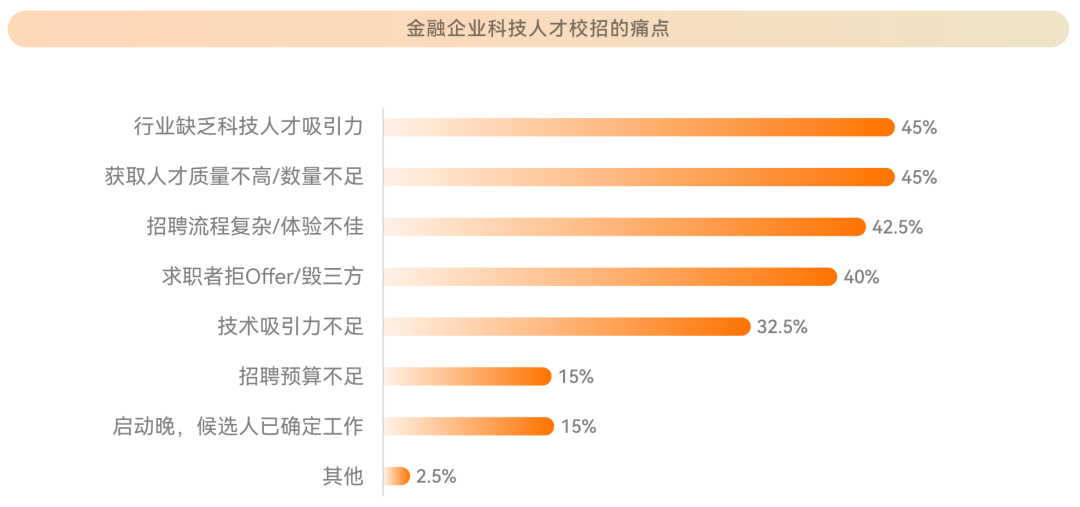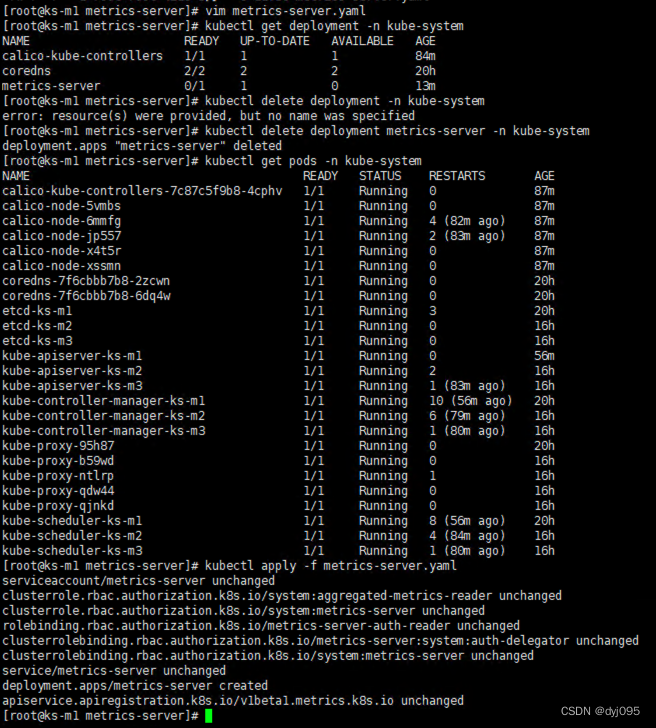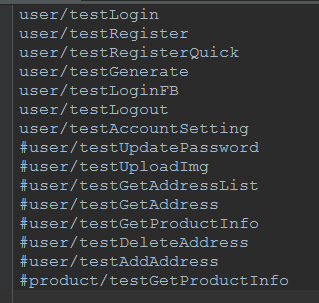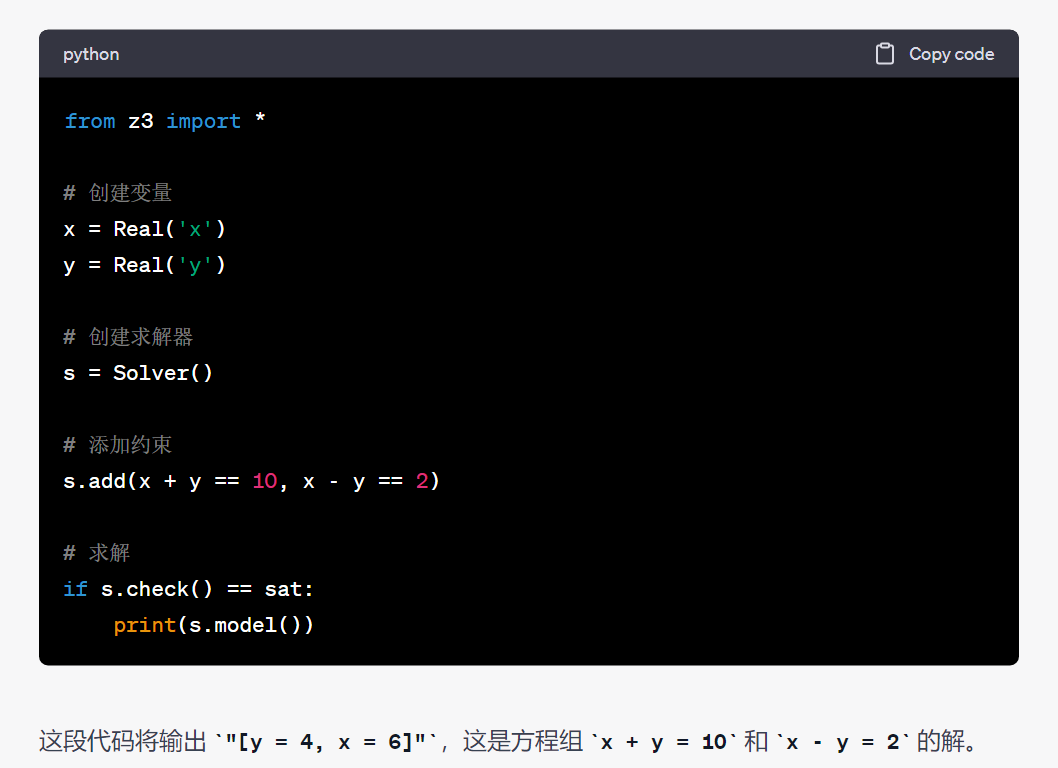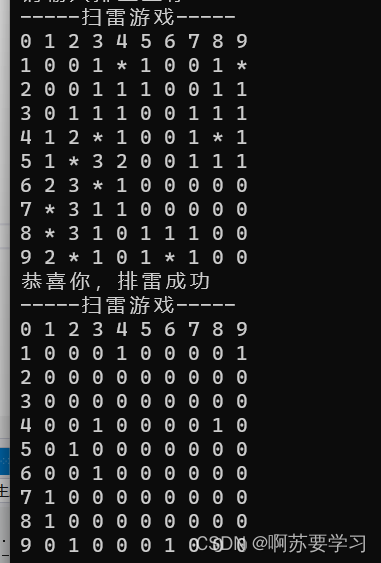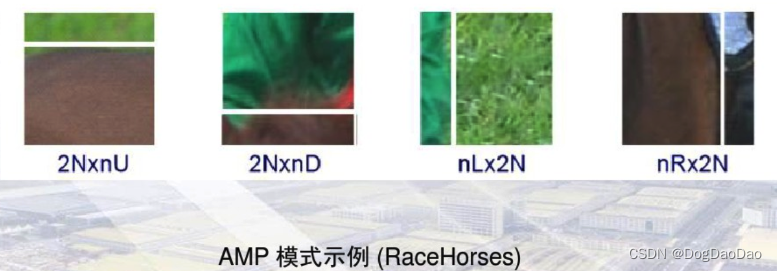嗯,又是发个重点,拿出来单独做笔记
本文有参考以下博文:
1、C++ template \ auto_c++ template auto_rainbow_lucky0106的博客-CSDN博客
2、C++ 中的 const & (常引用)参数 - 知乎
3、C++ template \ auto_c++ template auto_rainbow_lucky0106的博客-CSDN博客
4、C++模板类中的成员函数以及模板函数在类外定义的方式_模板类构造函数类外定义_云飞扬_Dylan的博客-CSDN博客
博主编译器版本是c++17
正常情况你打印一个数组
#include <iostream>
#include <windows.h>
#include <vector>
using namespace std;
// 程序的主函数
int main()
{
SetConsoleOutputCP(65001);
vector<int> v={7,5,10,12};
v.push_back(26);//类似js的push你懂的
cout<<"[";
for(int n:v){
cout<<n<<" ";
}
cout<<"]"<<endl;
v.pop_back();
cout<<"[";
for(int n:v){
cout<<n<<" ";
}
cout<<"]";
} 你们觉不觉得这个循环打印每次都要写一遍很烦?
你们觉不觉得这个循环打印每次都要写一遍很烦?
那咱就给他弄成个函数呗
#include <iostream>
#include <windows.h>
#include <vector>
using namespace std;
void print(vector<int> arr){
cout<<"[";
for(int n:arr){
cout<<n<<" ";
}
cout<<"]"<<endl;
}
int main()
{
SetConsoleOutputCP(65001);
vector<int> v={7,5,10,12};
v.push_back(26);//类似js的push你懂的
print(v);
v.pop_back();
print(v);
}
好,这样我们就得到了一个int型数组的打印,那如果我说我现在要打印一个char型的你是不是得改变量,
#include <iostream>
#include <windows.h>
#include <vector>
using namespace std;
void print(vector<int> arr){
cout<<"[";
for(int n:arr){
cout<<n<<" ";
}
cout<<"]"<<endl;
}
void printStr(vector<string> arr){
cout<<"[";
for(string n:arr){
cout<<n<<" ";
}
cout<<"]"<<endl;
}
int main()
{
SetConsoleOutputCP(65001);
vector<string> v={"你好啊","b","c","d"};
v.push_back("e");//类似js的push你懂的
printStr(v);
v.pop_back();
printStr(v);
}那有没有办法写一个函数,兼容string和int,都可以打印的办法,!有,模板
函数模板
#include <iostream>
#include <windows.h>
#include <vector>
using namespace std;
template <typename T>
void print(vector<T> arr){
cout<<"[";
for(T n:arr){
cout<<n<<" ";
}
cout<<"]"<<endl;
}
int main()
{
SetConsoleOutputCP(65001);
//字符串
vector<string> v={"你好啊","b","c","d"};
v.push_back("e");//类似js的push你懂的
print(v);
v.pop_back();
print(v);
//int型
vector<int> i={1,2,3,4};
i.push_back(5);//类似js的push你懂的
print(i);
i.pop_back();
print(i);
}
那C++ 模板 | 菜鸟教程 这里的inline T 是啥意思

来,你先去看博主的这一篇,看完在回来接下去往下看 ====》const&和int& const 理解笔记(图、代码、讲解)_雪狼之夜的博客-CSDN博客
你如果看完博主↑↑↑↑↑↑↑↑这篇完,你会知道const&干啥用的和为什么用它!!!然后你再看博主下面这个代码就不费劲了,
#include <iostream>
#include <windows.h>
using namespace std;
int const& CYC(int const& x,int const& y){
return x>y?x:y;
}
int main()
{
SetConsoleOutputCP(65001);
int a=1;
int b=2;
int c=CYC(a,b);
cout << c;
}![]()
来,这算进正题了
上面例子咱这么理解,
1、(int const& x,int const& y)代表形参是常整型引用(严谨点应该叫常量 int型 引用,叫习惯就好),
2、int const& CYC()的int const& 代表返回也是常整形引用。那这个例子就是代表,传入和返回的值是不能改的 都必须是长整型引用!!!!!!!!!!!!!!!!!!!!!!!!!
扩展下,你甚至可以再cyc里写 如下 返回
const int b=333;
const int* p;
p=&b;
return *p;也就是你可以拿形参判断完后 返回别的常整形引用。
那我们带入模板。你对比下上面的代码和下面的代码
#include <iostream>
#include <windows.h>
using namespace std;
template <typename T>
T const& CYC(T const& x,T const& y){ //int const&
// x=3; 因为是常量,所有你x不能给他赋值
return x>y?x:y;
}
int main()
{
SetConsoleOutputCP(65001);
int a=1;
int b=2;
int c=CYC(a,b);
cout << c;
}嗯,应该很好理解 把int的地方都替换成T。就跟我们博文最开始的那个地方一样,就是替换变量而已。所以你再去看 教程网的例子,就应该很好理解了。
来扩展下实验
#include <iostream>
#include <windows.h>
using namespace std;
template <typename T>
void CYC(T const& x,T const& y){ //int const&
}
int main()
{
SetConsoleOutputCP(65001);
int a=1;
string b="你好啊";
CYC(a,b);
}上面报错了哦!!!!!!!!!!!!!!!!
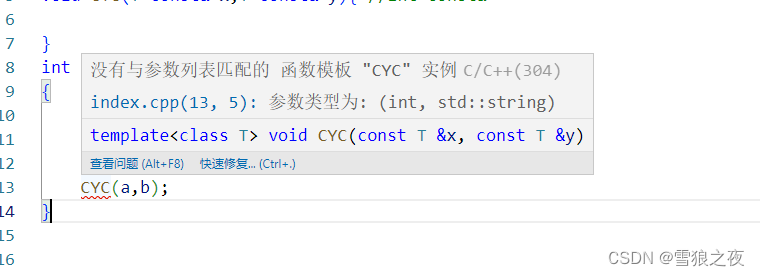
第一个是int 第二个是string,就报错了!,因为T不可能即是int又是string,那咋整,看下面代码
嗯,是这样的,咱定义两个自己T就可以拉。
#include <iostream>
#include <windows.h>
using namespace std;
template <typename T,typename T2>
void CYC(T const& x,T2 const& y){ //int const&
}
int main()
{
SetConsoleOutputCP(65001);
int a=1;
string b="你好啊";
CYC(a,b);
}问题又来了,那返回值怎么整??看下面代码
#include <iostream>
#include <windows.h>
using namespace std;
template <typename T,typename T2>//
auto const& CYC(T const& x,T2 const& y){ //int const&
return x;
// return y;
}
int main()
{
SetConsoleOutputCP(65001);
int a=1;
string b="你好啊";
cout<< CYC(a,b);
}
你是不是懂了,
至于auto可以不可以替换成T3,博主试了下,发现是不行的,如果知道怎么 操作的小伙伴麻烦评论区告诉下博主,谢谢
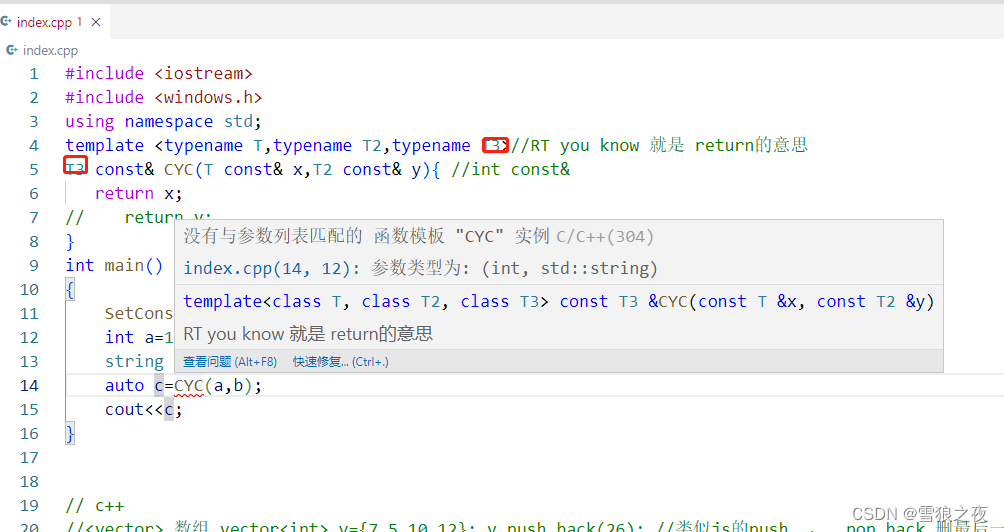
形参参数包 Args
也就是你可以传多个参数进去函数,(这个里面只能是同类型比如都是int 或者都是string)因为你没办法args[1] 、args[2]这样调用他
#include <iostream>
#include <windows.h>
using namespace std;
void FormatPrint()
{
std::cout << std::endl;
}
template <class ...Args> // 多个参数
void CYC(Args... args){ //int const&
int arr[] = { args... }; //列表初始化
//打印参数包中的各个参数
for (auto e : arr) {
cout << e << " ";
}
cout << endl;
//以下可以打印
// using var = int[];
// (void)var{0, (cout << args << endl, 0)...};
}
int main()
{
SetConsoleOutputCP(65001);
// int a=4;
// int b=2;
// string b="你好啊"; //不能同时传 char和int
CYC(10,15,7);
}
![]()
c++ 类模板
先从简单的开始,如下,这个是一个普通类
#include <iostream>
#include <windows.h>
using namespace std;
class CYC{
public:
int a=1;
CYC(int x){//构造函数
this->a=x;
};
void get(){
cout <<this->a;
};
};
int main()
{
SetConsoleOutputCP(65001);
CYC cyc(5);
cyc.get();
}
来,把类型int替换掉,改成模板
#include <iostream>
#include <windows.h>
using namespace std;
template<typename T>
class CYC{
public:
T a=1;
CYC(T x){//构造函数
this->a=x;
};
void get(){
cout <<this->a;
};
};
int main()
{
SetConsoleOutputCP(65001);
CYC<int> cyc(5);//和函数模板区别这里有多一个<int>传入参数类型申明注意
cyc.get();
}嗯,这就有点样子了,上面那个例子你理下,然后我们在把类构造函数和类成员函数放类外面定义如下
#include <iostream>
#include <windows.h>
using namespace std;
template<typename T>
class CYC{
T a=1;
public:
CYC(T x);//构造函数
void get(void);
};
template<typename T>
CYC<T>::CYC(T x){
this->a=x;
}
template<typename T>
void CYC<T>::get(void){
cout<< this->a;
}
int main()
{
SetConsoleOutputCP(65001);
CYC<int> cyc(5);//和函数模板区别这里有多一个<int>传入参数类型申明注意
cyc.get();
}类模板 友元处理
不知道申明是友元的 跑博主另一篇博文看===》c++类友元函数理解(图、文、代码)_雪狼之夜的博客-CSDN博客
#include <iostream>
#include <windows.h>
using namespace std;
template<typename T> //友元要先申明 !!!!!!!!!!!
void yyuan(T& cyc);
template<typename T>
class CYC{
T a=1;
public:
CYC(T x);//构造函数
void get(void);//普通类成员函数
friend void yyuan<>(CYC<T>& cyc);//友元
};
template<typename T>
CYC<T>::CYC(T x){
this->a=x;
}
template<typename T>
void CYC<T>::get(void){
cout<< this->a<<endl;
}
template<typename T>
void yyuan(T& cyc){
cout <<cyc.a<<endl;
}
int main()
{
SetConsoleOutputCP(65001);
CYC<int> cyc(5);//和函数模板区别这里有多一个<int>传入参数类型申明注意
cyc.get();
yyuan(cyc);
}
有人问为啥你是template<typename T> 不是 template<class T>,博主肯定的告诉你,这里两个都也可以,功能是一模一样的,习惯问题,来,博主附上文章,大家自己去看====》C++ 中 typename 和 class 的区别
